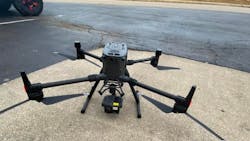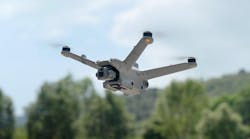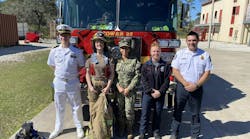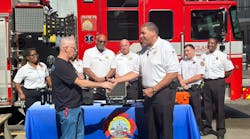Jan. 1—LONDON — Land searches can be risky to both the victim as well as the search members who often brave treacherous landscapes in extreme temperatures.
But through advanced technology, those searches have taken a huge step forward with the help of a highly technical drone recently acquired by the London-Laurel Rescue Squad.
The drone can perform multiple duties — serving as an airborne "eye" as well as a supply delivery source.
"This drone has three cameras with a thermal imaging gauge and an optical zoom up to 20X," said Lt. Gary Hall with the rescue squad. "With the drone, we can detect where someone is by their body temperature. It also has a laser range finder that can pinpoint a location and then we can use coordinates to locate where a person can be."
That source will benefit first responders involved in a land search or even firefighters who may discover that a person is trapped inside a collapsed or burning building.
The drone can also drop needed supplies to those trapped in the woods, river or lake or other areas.
"The drone can carry 7 pounds, sometimes more," Hall added. "We can drop food and other supplies with it. Like if someone is trapped on the river, we can send the drone out with a life vest for them. That will help them be safe until we can get there on foot."
Hall said the drone has the capability to illuminate thickets and wooded areas that are often obscured to the human eye.
"With the drone, we can locate people by covering an area faster than just going in on foot. The drone cameras can see places that are hard for us to see," he added. "This can fly, day or night, and runs 40 to 45 minutes on one battery. We have four other batteries, so we can charge them and have them ready if the other batteries go dead."
The drone can also operate in extreme temperatures in all kinds of weather.
"This can operate in temperatures as low as 2 below zero to 140 degrees Fahrenheit," he said. "We can use it in snow, rain and in winds up to 30 miles per hour without it being affected."
Another facet of the drone is that it is sensitive to objects — a safeguard against crashing into trees or other objects. During a demonstration of the drone, it hovered in the air when within a certain range of a person or object until the area was cleared.
"It won't land within a certain distance of something until we send the signal for it to land," Hall explained.
Chief John Allen said the addition of the drone to the rescue squad's equipment was a plus, not just for the rescue squad members but for other first responders as well.
"This will allow us to increase missions and be more efficient," he said. "We can send the drone out and pinpoint where someone is. We normally search a perimeter of where someone was last seen during land searches, but with the thermal imaging, we can pick up where someone is. If they are moving, the drone will follow them so we will know their location."
Allen added that the drone will also assist firefighters and other first responders.
"If there is a fire, we can use the thermal imaging to see if someone is still inside," he said. "We're here to assist other first responders — we will provide assistance with fires, accidents and other cases where the drone would be helpful. We all work together."
Allen said the drone itself cost $14,000 and the cameras were an additional $11,000.
"It's expensive, but it will eventually save lives," he said. "It's one of those things that we hope we never have to use, but if we do need it, we have it."
___
(c)2022 The Times-Tribune (Corbin, Ky.)
Visit The Times-Tribune (Corbin, Ky.) at www.thetimestribune.com
Distributed by Tribune Content Agency, LLC.






